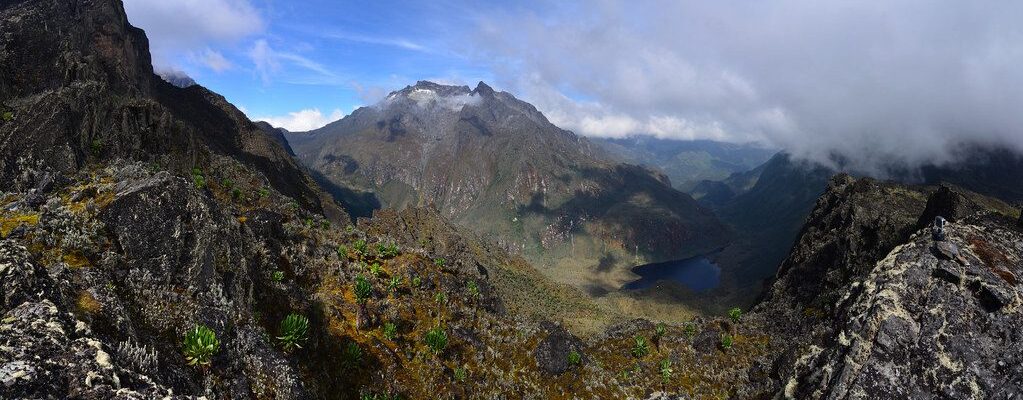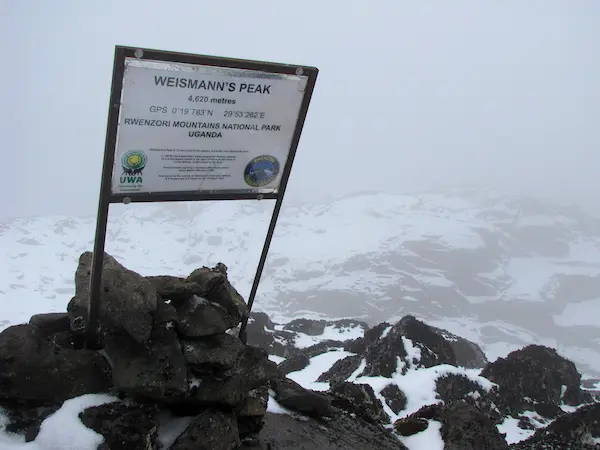
6 Days Weismann's Peak Hike Safari
Join our 6 days Weismanns Peak Route that takes you 4620M above sea level on the Rwenzori Mountains with a our local experts.
Tour Highlights
- Day 1: Starting Point- Sine Camp Kalama Camp.
- Day 2: Bambo-mimulopsis Zone- Mutanda Camp
- Day 2 Continued
- Day 3: Mutinda Valley- Namusangi Valley
- Day 4: Weismann’s Peak – Nyambwamba Valley.
- Day 5: Nyamwamba Valley to Starting Point.
- Day 6: Transfer back to Kampala.
Detailed Itinerary
Day 1: Starting Point- Sine Camp Kalama Camp.
Early morning from our starting point, we will start by walking up the valley floor through the Afro Montane Forest. During this climb you will have a chance to see blue monkeys and a variety of birds. Perfect for bird watching safaris. Occasionally, you may see the black and white colobus monkeys through the forest tree tops. Along this trail, there is a wide variety of plant species. These range from forest trees to low shrubs, flowers, bamboo thickets, fungi, and lichen and many moss covered vines hanging from the tall trees. Enock falls are just 150m from Sine Hut 2,596m and offer a splendid opportunity for a screensaver for your memories.
At Sine Camp we have wooden huts set between tall forest trees on a narrow ridge. These offer splendid views of the beautiful Afro Montane forest while you look down at the beautiful waterfall crashing over the rocks below. Sine is just below the bamboo zone and the area around has many different bird species. Overnight will be at Sine Camp or for those who are fit and want to proceed to Kalama Camp at 3,134m may do so and spend the night and dinner at Kalalama Camp
Day 2: Bambo-mimulopsis Zone- Mutanda Camp
After a good breakfast at your camp, start trekking by 8.30am and you enter the Bamboo-Mimulopsis Zone which is steep with high steps. During the wet season the bamboo zone is rather muddy and slippery making the going slow. The atmosphere and the forest is beautiful as you climb up 551m altitude and a distance of 1.8km to Kalalama Camp at 3,147m which is in the Heather-Rapanea Zone where you can take a rest and a quick cup of tea or coffee before heading on to Mutinda Camp.
The trail meanders up and over several small knolls along a ridge top, then drops down the side of the valley before climbing again. In doing so you will cross several small streams and pass close to moss covered waterfalls. You then climb steadily along the side of a beautiful mossy river. This tumbles down over the rocks under the Giant Heather trees whose trunks are covered in green moss with old man beards (Usnea lichen) hanging from the branches
Day 2 Continued
The trail twists and turns as you trek up the deep valley, which has an enormous variety of plants and flowers. The valley has many unique Giant Heather trees creating a beautiful atmosphere often shrouded in mist. Mutinda Camp which is set near a small river and waterfall offers a chance to wash, refresh and relax. In the afternoon you may wish to climb up to the top of the Mutinda Lookout and the view is amazingly beautiful as you stand on moss covered rocks at 3,925m with views across the Rwenzori Mountains and down to Kasese town and Lake George. For those clients who are climbing to Margherita or any of the main peaks climbing Mutinda to 3,975m is also an excellent way to acclimatise and reduce the risk of high altitude sickness. Overnight at the Camp
Day 3: Mutinda Valley- Namusangi Valley
Early morning you will embark on your journey cross the Mutinda valley through the tussock grass and everlasting flowers. The flowers are interspersed with many Giant Lobelias. You will then climb a steep section up to the Namusangi Valley 3,840m. Concluding this trail with sheer waterfalls and beautiful views of Mutinda Peaks. The Namusangi Valley is wide, with many ups and downs and crossing several bogs as the trail climbs steadily to Bugata Camp – 4,062m.
This camp is situated way up Bamwanjara Pass high above Bugata Lake with views across Lake Kopello to Weismann’s Peak. Weismann’s peak is often covered with snow. Further down the valley are scenic views of Lake Africa and Lake Tanganyika and plenty of small peaks towards Mutinda Camp. The area is covered with tussock grass, everlasting flowers (Helichrysum), St John’s Wort (Hypericum bequaertii), giant groundsel (Senecio adnivalis) and Giant lobelia (Lobelia gibberoa). There are a many Red Forest Duiker (Cephalophus nigrifrons rubidus) which are a sub-species only found in the Rwenzori Mountains.
Bugata Camp has good facilities, solar lights, good toilets and bathrooms. Therefore, if you fancy a warm birth this can be prepared for you. Bugata also has a helicopter pad (GPS reading N 18.312 E29 53.457) in case of any need for rescue by helicopter but be warned that a helicopter in Uganda costs around $10,000 per hour flying time which is way more than other countries so you need insurance in case of rescue
Day 4: Weismann’s Peak – Nyambwamba Valley.
You will climb Weismann’s Peak 4,620m and Stella Peak 4,626m, 3.7km to Weismann’s Peak then another 800m to Stella Peak and return. Total distance 9km 4 to 6 hours. The trek starts by walking across the hillside below high cliffs above Bugata Lake. Proceed around a ridge point to Lake Kopello where we walk along the edge of the lake. According to researchers the water temperature averages 2˚C.
As you climbing you get excellent views of the four lakes along the valley below. The last section to the peak is steep on solid rock. Therefore, it can be difficult when snowing or iced up and it may be necessary to use ropes for safety. On a clear day you get awesome views of all the main peaks, Mt Stanley, Mt Speke and Mt Baker. The top of Weismann’s Peak is relativity flat or dome shaped with deep moss growing on the rocks creating a beautiful atmosphere. Stella Peak 4,626m is near Weismann’s Peak but needs full technical experience and a good head for heights. We do not advise crossing to Stella Peak.
Picture of Weismann’s peak
From the peak we descend directly to Kiharo Camp 3,460m down the Nyamwamba Valley. At the head of the valley there is a large area of thick giant groundsel. Coupled with dense evergreen undergrowth and moss with the rocky peaks towering above which creates its own micro environment. As you descend the valley you will notice the terrain is made up of several flat boggy areas. This is where millions of years ago glaciers sat and melted leaving a wall of big rocks where it lay. The valley is home to many Red Forest Duiker. At night you may stay in Kiharo Camp at 3,460m an area rich in evergreen plants and babbling streams. Particularly during the dryer months the night the air is filled with the calls of the rock hyrax as they sit in the rocky cliffs high above
Day 5: Nyamwamba Valley to Starting Point.
The trail down the Nyamwamba Valley is mostly downhill and absolutely stunning with beautiful views. The moss covered rocks along the river, cascading waterfalls, deep valleys and forests are possibly the best in the Rwenzori Mountains. A few kilometres from Kiharo Camp, the path turns off to the right to pass along the river. In the clear areas you may catch a glimpse of a Duiker quietly feeding as you pass along the river. If you wish you may prefer to walk down the river itself hopping across the rocks as you pass down.
A few kilometres down the river it becomes very steep with multitudes of waterfalls. Therefore we have to move away from the river and follow a narrow ridge to bypass steep sections. At the bottom we again meet the river where there is a huge rock shelter and a place to rest. After crossing a small stream you climb up a gentle slope before turning back down to the river to avoid another set of waterfalls which are impassable. The forest along this section is magnificent and full of life with many birds, primates, duikers and hyrax. Trek back to your starting point for dinner and overnight
Day 6: Transfer back to Kampala.
Early morning after breakfast, prepare to leave for your journey back to Kampala. Drop off at your preferred place in Kampala. End of will be 6 days Wisemann’s peak Hike.

